

Ecocentric. This Week in Eco News - April 18, 2014 Did you know that NFL linebacker Will Witherspoon is also an organic beef producer?

Or that it's possible to extract water from the air? Or fuel from seawater? See these stories, along with climate news and fun multimedia, in this week's Eco News. Our Heroes: Gordian Raacke of Renewable Energy Long Island. Seasonal Chef. Mission:Explore Food—Sustainable Seafood. The ocean plays a critical role in everyone's life, no matter where they are located.
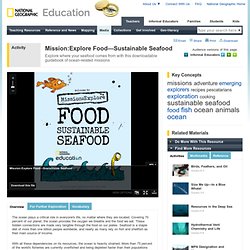
Covering 70 percent of our planet, the ocean provides the oxygen we breathe and the food we eat. These hidden connections are made very tangible through the food on our plates. Seafood is a staple diet of more than one billion people worldwide, and nearly as many rely on fish and shellfish as their main source of income. With all these dependencies on its resources, the ocean is heavily strained.
More than 75 percent of the world's fisheries are currenlty overfished and being depleted faster than their populations can replenish. These 20 seafood-related missions find their basis in your local community and explore some of the issues our ocean is facing in a fun, hands-on way. Holliston Science Webquest - Genetically Modified Foods. Toolkit for “Serving Up Justice at School” Overview: This toolkit accompanies the article “Serving Up Justice at School,” and provides a classroom activity that engages students in learning about the food in their daily lives through an interdisciplinary social-action project.
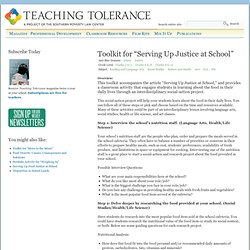
This social-action project will help your students learn about the food in their daily lives. You can follow all of these steps or pick and choose based on the time and resources available. Many of these activities could be part of an interdisciplinary lesson involving language arts, social studies, health or life science, and art classes. What's on Your Plate? What's on your plate?
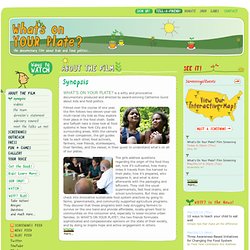
Is a witty and provocative documentary produced and directed by award-winning Catherine Gund about kids and food politics. Filmed over the course of one year, the film follows two eleven-year-old multi-racial city kids as they explore their place in the food chain. Sadie and Safiyah take a close look at food systems in New York City and its surrounding areas. With the camera as their companion, the girl guides talk to each other, food activists, farmers, new friends, storekeepers, their families, and the viewer, in their quest to understand what’s on all of our plates. FoodDay2013_SchoolCurriculum_FINAL.pdf. Us-veg-sample.pdf. Food Education. Food manufacturers and fast-food chains spend billions convincing kids to want junk food, placing ads on Nickelodeon, and even reaching kids through apps and online games.

Partly as a result, one in three children is overweight or obese, and kids are being diagnosed with type 2 diabetes at younger and younger ages. We believe that all children should understand the story of their food: where it comes from, how it was produced, and what it means for personal and public health. Equipping children with food and nutrition education—in the kitchen and in the classroom— will empower them with lifelong skills. Research on food education has proven that:
Lesson_19.pdf. Lesson_11.pdf. Lesson_3.pdf. Find out what's REALLY in your food. - Home. Food Additives ~ CSPI’s Food Safety. Coloring, nutrient: Margarine, shortening, non-dairy whiteners, beverages, breakfast cereals, supplements.
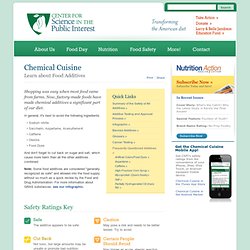
Coloring, nutrient Beta-carotene is used as an artificial coloring and a nutrient supplement. The body converts it to Vitamin A, which is part of the light-detection mechanism of the eye and which helps maintain the normal condition of mucous membranes. Large amounts of beta-carotene in the form of dietary supplements increased the risk of lung cancer in smokers and did not reduce the risk in non-smokers. Decoding Ingredients: Different Names for Unhealthy Items. Food manufacturers sure don’t make it easy for consumers to shop conscientiously.

We have to do homework just to decipher the nutrition labels on the backs of boxes and cans, otherwise they’re just a mess of percentages and multi-syllabic words. Even just trying to avoid certain ingredients is hard enough; manufacturers want you to buy their stuff, so they don’t want to make questionable content too obvious. As a result, ingredient lists on processed foods are long, jumbled, and full of words you’d need a science background to understand. Printable Handy Nutrient Claims Reference Chart. Www.loveumadly.com/2012/04/100-pure-love-for-100-real-fruit-snacks/ Issues You Should Know About Network Marketing Look at the recommendations in this article and discover tips on how to become successful at internet marketing.
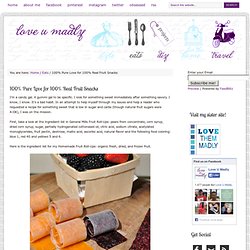
You must hold standard events for your personal staff. It really is beneficial for the entire staff once you all gathering consistently. Put in place your multilevel marketing website being a tutorial is to establish. Junk food. WebQuest. Healthy Food vs.
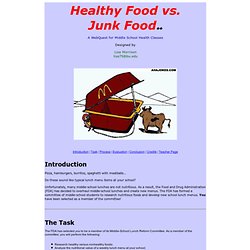
Junk Food A WebQuest for Middle School Health Classes Designed by. Family and Consumer Science / Fast Food Web Quest. Family and Consumer Science Department Foods and Nutrition A web quest for Sycamore High School Designed by Mrs.

Meitl Cmeitl@syc427.org Since the advent of the drive-up fast-food restaurant in the 1950's, fast food has become an increasingly popular form of eating in the United States. Where in the World Does our Food Come From? What To Do: Summer’s ripe with all-American bashes from Memorial Day and the Fourth of July through Labor Day. Are the foods we’re stocking up on to serve now and all year 'round equally all-American? Not always. Although many of us try to buy items produced in the U.S., we may be surprised to find out that some ingredients in those items are imported.
97.07.07: From the Farm to Your Table: Where Does Our Food Come From? Where does your food come from? Got Milk? Undefined - Fresh from the World... Where Your Food Comes From. The Story of our Food. Every time we eat a piece of food, we take a bite out of the world. All these small bites tell a dozen stories. A carton of eggs presents the story of contented hens, a bottle of olive oil the tale of Italian grandmothers.
Food Stories. Sanctuary. BPH Versus Prostate Cancer First, a few basics: The prostate is a gland found beneath the bladder. It surrounds the urethra, the tube the bladder uses to pass urine, and it also produces most semen (along with the seminal vesicles). At puberty, the prostate is about walnut size, and there is normal growth as a man ages. But when the prostate becomes too large, it places excessive pressure on the urethra, which causes men to experience frequent urination, urinary urges, a weak urine stream, urine retention and pain when urinating. Many guys immediately fear they have prostate cancer, but BPH is an unrelated condition.
“While the symptoms are similar, BPH is not life-threatening and does not put you at a higher risk for developing prostate cancer,” Dr. As for prostate cancer, approximately 234,000 men face this diagnosis each year, according to the Prostate Cancer Foundation. Institute for Responsible Technology - Nature’s Express – Berkeley Restaurant First In North America to Offer a Non-GMO Project Verified Menu. July 2, 2012 Berkeley, CA – June 27, 2012 – Nature’s Express, a restaurant in Berkeley, California has become the first restaurant to offer menu items verified by the Non‐GMO Project. At natural grocery stores, Non‐GMO Project Verified is already the fastest growing label claim in the industry, with over $2 billion in annual sales. With this inaugural restaurant verification, Nature’s Express is paving the way for the restaurant sector to follow suit. GMOs, or “Genetically Modified Organisms,” are plants or animals created through the process of genetic engineering. For Parents & Kids.
Best_worst.pdf. Food history lesson plans. 7th Grade Activites. 7th Grade. MiddleSchool Excel Assignment. 28gm_harvest.pdf. Microsoft Word - Student Book - 7th grade Lesson 13.doc - student book - 7th grade lesson 13.pdf. Nutrition facts, calories in food, labels, nutritional information and analysis – NutritionData.com.
'Hunger Games' Science: Investigating Genetically Engineered Organisms. Overview | What lessons can we learn about genetically engineered organisms from the example of the jabberjay, a fictional bird in the movie “The Hunger Games”? The ‘Hunger Games’ Mockingjay - Fiction, for Now. DIYbio. Non-GMO Shopping Guide. 4 examples of genetically modified crops. 28gm_harvest.pdf. Organic Farming and Genetically Modified Organisms.